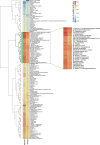Sympathetic nervous activation, mitochondrial dysfunction and outcome in acutely decompensated cirrhosis: the metabolomic prognostic models (CLIF-C MET)
- PMID: 36788015
- PMCID: PMC10359524
- DOI: 10.1136/gutjnl-2022-328708
Sympathetic nervous activation, mitochondrial dysfunction and outcome in acutely decompensated cirrhosis: the metabolomic prognostic models (CLIF-C MET)
Erratum in
-
Correction: Sympathetic nervous activation, mitochondrial dysfunction and outcome in acutely decompensated cirrhosis: the metabolomic prognostic models (CLIF-C MET).Gut. 2023 Nov;72(11):e4. doi: 10.1136/gutjnl-2022-328708corr1. Gut. 2023. PMID: 37802539 Free PMC article. No abstract available.
Abstract
Background and aims: Current prognostic scores of patients with acutely decompensated cirrhosis (AD), particularly those with acute-on-chronic liver failure (ACLF), underestimate the risk of mortality. This is probably because systemic inflammation (SI), the major driver of AD/ACLF, is not reflected in the scores. SI induces metabolic changes, which impair delivery of the necessary energy for the immune reaction. This investigation aimed to identify metabolites associated with short-term (28-day) death and to design metabolomic prognostic models.
Methods: Two prospective multicentre large cohorts from Europe for investigating ACLF and development of ACLF, CANONIC (discovery, n=831) and PREDICT (validation, n=851), were explored by untargeted serum metabolomics to identify and validate metabolites which could allow improved prognostic modelling.
Results: Three prognostic metabolites strongly associated with death were selected to build the models. 4-Hydroxy-3-methoxyphenylglycol sulfate is a norepinephrine derivative, which may be derived from the brainstem response to SI. Additionally, galacturonic acid and hexanoylcarnitine are associated with mitochondrial dysfunction. Model 1 included only these three prognostic metabolites and age. Model 2 was built around 4-hydroxy-3-methoxyphenylglycol sulfate, hexanoylcarnitine, bilirubin, international normalised ratio (INR) and age. In the discovery cohort, both models were more accurate in predicting death within 7, 14 and 28 days after admission compared with MELDNa score (C-index: 0.9267, 0.9002 and 0.8424, and 0.9369, 0.9206 and 0.8529, with model 1 and model 2, respectively). Similar results were found in the validation cohort (C-index: 0.940, 0.834 and 0.791, and 0.947, 0.857 and 0.810, with model 1 and model 2, respectively). Also, in ACLF, model 1 and model 2 outperformed MELDNa 7, 14 and 28 days after admission for prediction of mortality.
Conclusions: Models including metabolites (CLIF-C MET) reflecting SI, mitochondrial dysfunction and sympathetic system activation are better predictors of short-term mortality than scores based only on organ dysfunction (eg, MELDNa), especially in patients with ACLF.
Trial registration: ClinicalTrials.gov NCT03056612.
Keywords: cirrhosis; liver failure; liver metabolism.
© Author(s) (or their employer(s)) 2023. Re-use permitted under CC BY-NC. No commercial re-use. See rights and permissions. Published by BMJ.
Conflict of interest statement
Competing interests: None declared.
Figures


Comment in
-
Catecholamines and inflammation in advanced liver disease: more closely intertwined than expected?Gut. 2024 Jun 6;73(7):1219-1222. doi: 10.1136/gutjnl-2023-330535. Gut. 2024. PMID: 37468229 No abstract available.
References
Publication types
MeSH terms
Substances
Associated data
LinkOut - more resources
Full Text Sources
Medical
Miscellaneous
